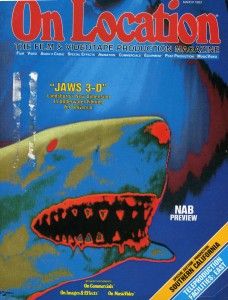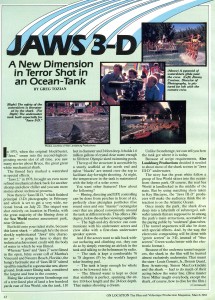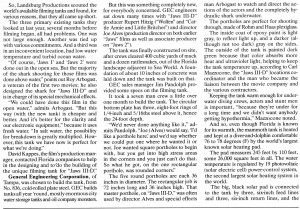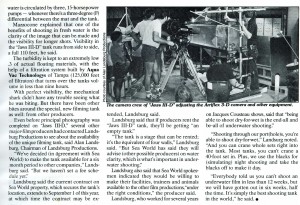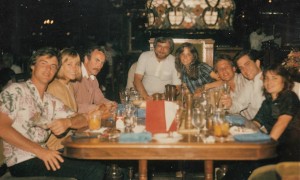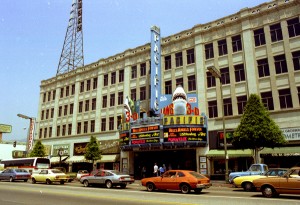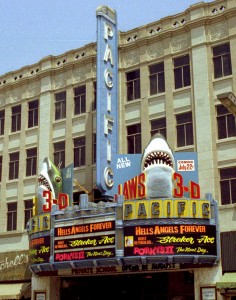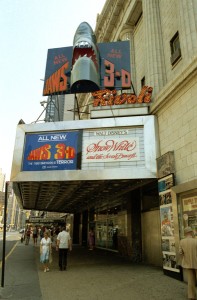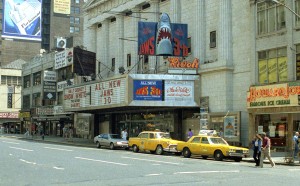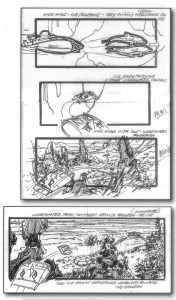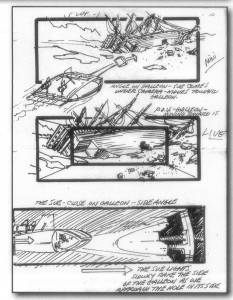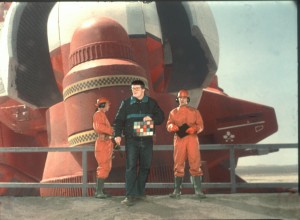 Spécialiste des effets spéciaux optiques, Spencer Gill a travaillé sur des films aussi variés que le Caveman de Carl Gottlieb, les deux premiers Robocop, Ghostbusters 2, le formidable Robojox de Stuart Gordon (la photo à gauche) ou bien encore La malédiction des rats (Gnaw/ Food of gods: part 2) et le 5ème épisode des aventures de Freddy Krueger… Autant dire un CV en béton! Mais comme vous pouvez l’imaginer, Spencer a surtout oeuvré sur notre film préféré et à 24 heures du trentième anniversaire de Jaws 3D, il nous dévoile tout!
Spécialiste des effets spéciaux optiques, Spencer Gill a travaillé sur des films aussi variés que le Caveman de Carl Gottlieb, les deux premiers Robocop, Ghostbusters 2, le formidable Robojox de Stuart Gordon (la photo à gauche) ou bien encore La malédiction des rats (Gnaw/ Food of gods: part 2) et le 5ème épisode des aventures de Freddy Krueger… Autant dire un CV en béton! Mais comme vous pouvez l’imaginer, Spencer a surtout oeuvré sur notre film préféré et à 24 heures du trentième anniversaire de Jaws 3D, il nous dévoile tout!
I started working at Robert Blalack’s company Praxis Film Works (ILM occupied the building and when Lucas moved ILM to the San Francisco area Robert Blalack decided to stay in North Hollywood) when he was crewing-up for Jaws 3-D. The Praxis crew took two weeks to devise a practical method for shooting 3-D (for conventional, motion control miniatures) and Chris Regan in optical outfitted the two printers at Praxis with very precise, electronic micrometers so that we could both adjust convergence (I did mention that most of it was shot in SpaceVision but was converted to Arrivision during post production. Had they stayed with the plan that the folks at Private Stock Effects (the Skotack Brothers specifically) which was a 605 line video system the composites would’ve been loads better.
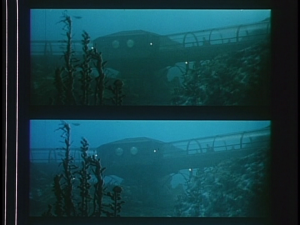 Working with third generation duplicate negatives it was a miracle that it looked as good as it did. I was purely an optical cameraman (I operated an optical printer) and when I made suggestions I was politely ignored so the film was just a paycheck. It was a pleasant enough experience (although Praxis didn’t pay very well) but it was irritating having good advice ignored. The most amazing thing was that the optical supervisor would run the Friday night comps to the lab (if he got ’em there early enough we’d have dailies on Saturday) and in spite of having to drive through Hollywood Bowl traffic (this was in summer during the season for the Bowl) he got the film there. I wonder how that was even physically possible…
Working with third generation duplicate negatives it was a miracle that it looked as good as it did. I was purely an optical cameraman (I operated an optical printer) and when I made suggestions I was politely ignored so the film was just a paycheck. It was a pleasant enough experience (although Praxis didn’t pay very well) but it was irritating having good advice ignored. The most amazing thing was that the optical supervisor would run the Friday night comps to the lab (if he got ’em there early enough we’d have dailies on Saturday) and in spite of having to drive through Hollywood Bowl traffic (this was in summer during the season for the Bowl) he got the film there. I wonder how that was even physically possible…
Convergence is always an issue in 3-D but when you are shooting several layers that must fall into the right place for proper depth it become a problem. Miniature buildings resting on full-sized sections of underwater pylons must be aligned for north/south and east/west and for depth convergence.
Le problème majeur du film est bien évidemment le changement de dernière minute de l’ Electronic Compositing aux effets optiques… En tant qu’ ex-membre de l’équipe Praxis, votre point de vu est très intéressant.
The decision to switch over and under formats (from SpaceVision to ArriVision) was done quite late (virtually all footage was shot before the switch. The executives from Universal decided that they liked the look of the photochemical composites based on their tastes and their taste was … as the expression goes … in their ass. No one (not even at Praxis) told them that the film composites were superior and we (at Praxis) thought they were crazy. They would also measure the convergence on the projection screen and calculate which version to use. We all (at Praxis’ optical department and management) agreed that their choices induce headaches and eye strain. We would shoot it the executive’s way and then properly and tell editorial which we thought was the correct take. They invariably agreed with us.
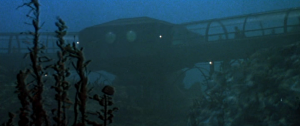 Est-ce que l’utilisation de fond vert vous a posé problème?
Est-ce que l’utilisation de fond vert vous a posé problème?
In film composites greenscreen is a bit of a problem since the green separation has the most detail and when using separations you often don’t use the separation that matches the color for the traveling matte for the foreground pass. In bluescreen that means you use the green separation for a blue pass as well as for the green. If you have some green or yellow in the foreground you’ll either create a synthetic blue (one pass through the green filter to darken the bluescreen area and a second pass with the blue filter to add the grain from the blue layer) or create a color difference matte (the green separation plus the color negative using the blue filter which yields dark areas where there is a difference between the blue and the green) or use both. Since they were paying so little for each shot we just used the red and the blue separations and the shots were very grainy and had bad contrast.
The doctored IP system (no seperations and you turned the greenscreen area black on the interpositive) would’ve looked a lot better but they didn’t want to send the original negatives to the non-union optical house (Praxis) which is unbelievably stupid.
Trois plans du film ont été monté sans que les effets spéciaux ne soient finalisés. En résulte des scènes de panique dans les tunnels et un fond vert clairement visible. Selon Mitch Katlin, la firme Praxis avait bien réalisé des composites et ne s’explique pas sur leur absence à l’écran? Pouvez-vous confirmer?
Oh yes … we did do composites but the backgrounds remained stationary which made it look as if the foreground was moving. Since they didn’t want to spend the money for a hand animated pre-optical (an optical done prior to the final composite used as part of the composite) we could not attempt to match the camera move. Those moving shots were done to use the « Harry » (an electronic tool that was newly available at the time) and when they switched to film the executives didn’t realize that it was a problem.
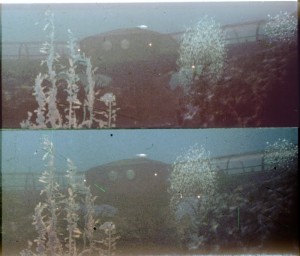 Certains membres de PSE ont soupçonné le lobby des effets spéciaux optiques, craignant l’ Electronic Compositing, d’avoir donné sciemment de mauvais conseils à Alan Landsburg. Que pensez-vous de cette théorie? Avez-vous vu le travail de PSE avant de vous attaquer à Jaws 3D?
Certains membres de PSE ont soupçonné le lobby des effets spéciaux optiques, craignant l’ Electronic Compositing, d’avoir donné sciemment de mauvais conseils à Alan Landsburg. Que pensez-vous de cette théorie? Avez-vous vu le travail de PSE avant de vous attaquer à Jaws 3D?
There was no « optical house lobby » … the executives at Universal made all of those bad decisions on their own. Robbie Blalack wasn’t about to scream « are you insane!?!?!? The electronic composites were clearly superior!! » He just asked which they preferred and came back and told us whatever damned stupid thing they wanted done next.
J’ai eu l’opportunité de voir Jaws 3D en 35mm à la CINEMATHEQUE DE PARIS en décembre 2009. Tous les effets Pop-up étaient très impressionnants. Selon le magazine The American Cinematographer, ces effets auraient été reshooté par Praxis… Qu’en est-il?
Yeah … our stage crew reshot a lot of that stuff. If we had converged it the way the executives wanted us to do it would’ve caused major eyestrain. We all got sick to our stomachs (just shy of actally vomiting) at Praxis and Robbie told us to shoot it properly and not give them the option of choosing the bad version.
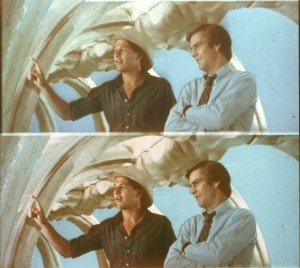 La fameuse séquence du requin brisant la vitre de la salle de contrôle est aussi l’oeuvre de Praxis? Avez-vous participé à cette scène? Quel modèle de requin a été utilisé lors du tournage?
La fameuse séquence du requin brisant la vitre de la salle de contrôle est aussi l’oeuvre de Praxis? Avez-vous participé à cette scène? Quel modèle de requin a été utilisé lors du tournage?
I was only involved in so far as I told the stage crew to darken the bluescreen (it was over exposed). At this late date who knows which miniature was used.
Une dernière chose… Demain, c’est le trentième anniversaire du film. Votre avis sur le film après tout ce temps…
At the time we were all upset by the huge number of stupid decisions so we were all rether dismissive of the film. Years later seeing it on TV in pan-and-scan versions it seems a better film … that looks like crap. The majority of the early 1980s 3-D films were not very good.
Merci à Spencer Gill pour l’interview et pour son énorme cadeau: 2 photogrammes under-and-over (issues du workprint) complètement inédits. La colorimétrie et la précision de la première (en comparaison du DVD et de la copie 35) est différente. La seconde est encore plus folle puisqu’il s’agit d’une scène coupée déjà traitée ici même.
Partager la publication "Interview avec Spencer Gill (Praxis Filmworks)"
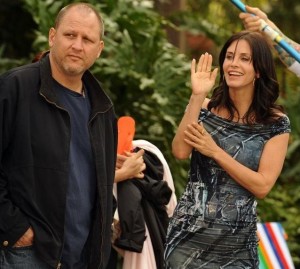 52 ans pour notre ami John Putch (ici en compagnie de la sublime Courtney Cox). Ah, il est désormais lointain le temps où John jouait le rôle d’un étudiant en vacances en Floride à la recherche d’un job d’été! Alors même si l’année 2013 a été particulièrement difficile pour lui (il a perdu sa mère Jean Stapleton le 31 mai dernier) on lui souhaite un joyeux anniversaire et beaucoup de réussite pour ses prochains projets cinématographiques. J’aurais bien voulu obtenir de lui quelques mots à propos du trentième anniversaire de Jaws 3D mais John travaille actuellement sur le tournage du troisième volet de sa saga Route 30… On allait pas le perturber à ce stade de la production! Allez, tous ensemble: HAPPY BIRTHDAY JOHN!
52 ans pour notre ami John Putch (ici en compagnie de la sublime Courtney Cox). Ah, il est désormais lointain le temps où John jouait le rôle d’un étudiant en vacances en Floride à la recherche d’un job d’été! Alors même si l’année 2013 a été particulièrement difficile pour lui (il a perdu sa mère Jean Stapleton le 31 mai dernier) on lui souhaite un joyeux anniversaire et beaucoup de réussite pour ses prochains projets cinématographiques. J’aurais bien voulu obtenir de lui quelques mots à propos du trentième anniversaire de Jaws 3D mais John travaille actuellement sur le tournage du troisième volet de sa saga Route 30… On allait pas le perturber à ce stade de la production! Allez, tous ensemble: HAPPY BIRTHDAY JOHN!


